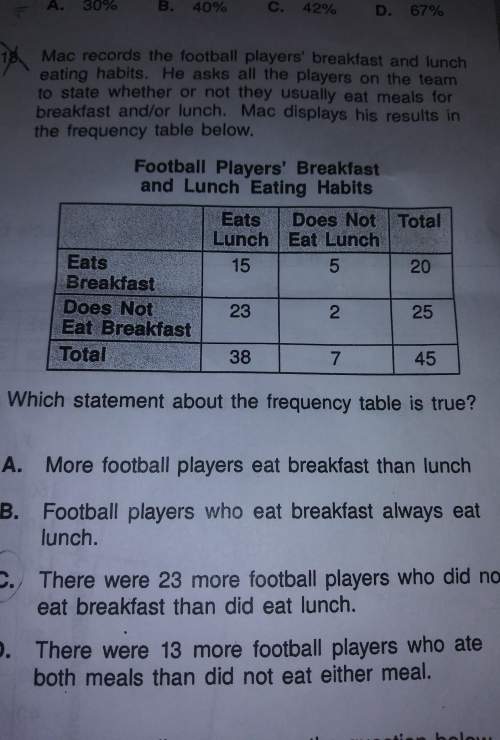
Mathematics, 13.05.2021 17:30 megaboy
Sam commutes to work by bus. He has to make two transfers. Historically, he has to wait more than five minutes for the first transfer 10% of the time. If he has to wait more than five minutes for the first transfer, he has to wait more than five minutes for the second transfer 30% of the time. If he does not have to wait more than five minutes for the first transfer, then he has to wait more tha five minutes for the second transfer 40% of the time. Are the events, wait more than five minutes for the first transfer and wait more than five minutes for the second transfer, independent?
a) No. Since the probability of waiting more than five minutes for the second transfer is different depending on whether Sam waits more than five minutes for the first transfer, these events are not independent events.
b) No. Since the probability of waiting more than five minutes for the second transfer is the same regardless of whether Sam waits more than five minutes for the first transfer, these events are not independent.
c) Yes. Since the probability of waiting more than five minutes for the second transfer is different depending on whether Sam waits more than five minutes for the first transfer, these events are independent events.
d) Yes. Since the probability of waiting more than five minutes for the second transfer is the same regardless of whether Sam waits more than five minutes for the first transfer, these events are independent events

Answers: 3


Another question on Mathematics

Mathematics, 21.06.2019 17:00
Suppose i flip two identical coins. what is the probability that i get one head and one tail?
Answers: 2

Mathematics, 21.06.2019 17:30
Lems1. the following data set represents the scores on intelligence quotient(iq) examinations of 40 sixth-grade students at a particular school: 114, 122, 103, 118, 99, 105, 134, 125, 117, 106, 109, 104, 111, 127,133, 111, 117, 103, 120, 98, 100, 130, 141, 119, 128, 106, 109, 115,113, 121, 100, 130, 125, 117, 119, 113, 104, 108, 110, 102(a) present this data set in a frequency histogram.(b) which class interval contains the greatest number of data values? (c) is there a roughly equal number of data in each class interval? (d) does the histogram appear to be approximately symmetric? if so,about which interval is it approximately symmetric?
Answers: 3

Mathematics, 21.06.2019 23:30
Dawn is selling her mp3 player for 3 4 of the original price. the original price for the mp3 player was $40. how much is she selling her mp3 player for?
Answers: 1

Mathematics, 22.06.2019 00:00
Which statement explains the relationship between corresponding terms in the table?
Answers: 1
You know the right answer?
Sam commutes to work by bus. He has to make two transfers. Historically, he has to wait more than fi...
Questions

Social Studies, 29.10.2020 14:00

World Languages, 29.10.2020 14:00

History, 29.10.2020 14:00


Computers and Technology, 29.10.2020 14:00

Biology, 29.10.2020 14:00

Mathematics, 29.10.2020 14:00

Biology, 29.10.2020 14:00

English, 29.10.2020 14:00

Mathematics, 29.10.2020 14:00

Mathematics, 29.10.2020 14:00


Spanish, 29.10.2020 14:00

English, 29.10.2020 14:00

Biology, 29.10.2020 14:00

Mathematics, 29.10.2020 14:00

Spanish, 29.10.2020 14:00

English, 29.10.2020 14:00





